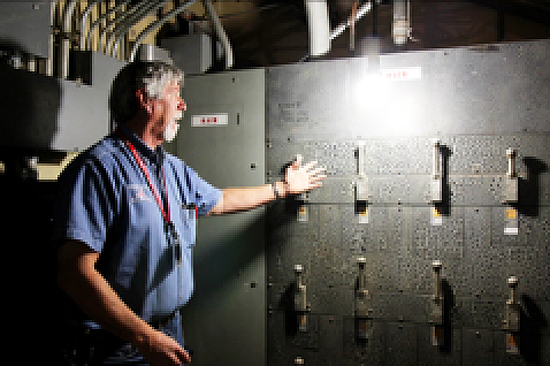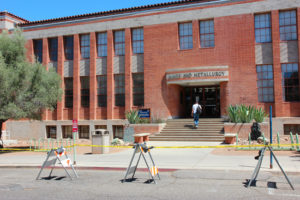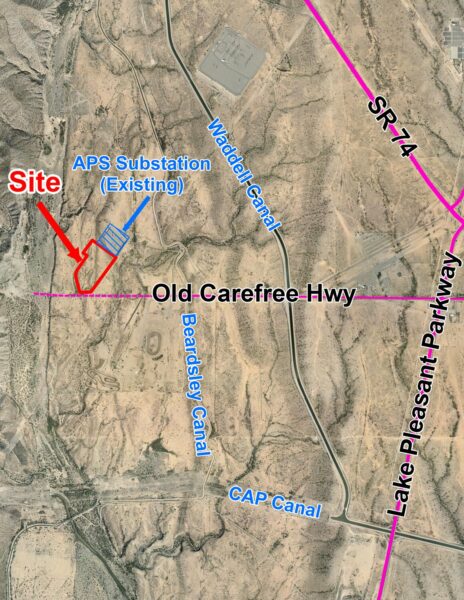
When the Great Recession hit, Arizona’s university budgets were slashed. With a billion-dollar university infrastructure plan now in the pipeline, the University of Arizona has committed nearly half of its portion of the funds to address the mounting maintenance costs that were pushed off for the past decade, and that started causing problems already.
By Julianne Stanford | Arizona Center for Investigating Reporting
 UCSON, Ariz. – On a sweltering afternoon in the middle of summer last year, patients at the Banner-University Medical Center at the University of Arizona suddenly had to be evacuated and moved to the neighboring Diamond Children’s Medical Center when the power cut out. A surge of electricity had overloaded the hospital’s circuit breaker, knocking out the building’s primary power and causing the backup generator to burst into flames. The hospital’s basement mechanical room filled with smoke, which floated up to the patient floor above.
UCSON, Ariz. – On a sweltering afternoon in the middle of summer last year, patients at the Banner-University Medical Center at the University of Arizona suddenly had to be evacuated and moved to the neighboring Diamond Children’s Medical Center when the power cut out. A surge of electricity had overloaded the hospital’s circuit breaker, knocking out the building’s primary power and causing the backup generator to burst into flames. The hospital’s basement mechanical room filled with smoke, which floated up to the patient floor above.
Tucson Fire Department investigators quickly identified the culprit: an equipment failure in a university building next door. Because the two buildings’ electrical systems are linked, it caused a chain reaction that affected both buildings.
When the university facilities management crew began repairing the problems, they found equipment and parts that were so old, it would be nearly impossible to fix them. Scouring eBay was the only way to find the fuses they needed.
“A lot of the equipment in there is from the 1960s,” said Chris Kopach, Assistant Vice President of Facilities Management at the University of Arizona.
Since the fire, the university’s facilities management department has been working on separating the two electrical systems “so, if Banner did have a failure on their end, the university’s equipment would continue to stay up,” and vice versa, Kopach said.
That “catastrophic failure,” was the result of years of maintenance that wasn’t performed on the system because of a lack of funding, Gregg Goldman, the senior vice president for business affairs and chief financial officer for the University of Arizona, told the Arizona Board of Regents in November 2016.
Unexpected maintenance nightmares caused by aging systems aren’t entirely uncommon at Arizona’s public universities, but university administrators and public officials are hopeful that a plan recently passed by the Legislature and signed by Gov. Doug Ducey will help address the mounting challenge.
“It’s been an ongoing concern,” said Arizona Board of Regents President Eileen Klein. “It’s been an operating concern for the universities and it’s been a big, growing business concern for us.”
In the face of insufficient resources, gutted budgets and reduced state funding, maintenance concerns for aging buildings and backlogged upkeep has turned into a ticking “time bomb,” Goldman said.
The universities are now getting a much needed injection of funding with a $1 billion bonding package built into the state’s 2018 budget. The funds are slated to address the long-needed deferred maintenance projects and also fund new research and development facilities.
“Today will be remembered as one that paved the way for decades of breakthroughs at our universities; one that opened the door for Arizona students to receive the highest-caliber university experience; and one that makes Arizona second to none in support of higher education,” Gov. Doug Ducey said in a May 22 statement after signing the bill that authorized the funding.
Starting in 2019, the universities will receive $27 million per year for the next 25 years from the state’s general fund, with an annual increase to match inflation up to 2 percent. The universities will in turn match state funding with money from their own budgets to go towards research and development projects and deferred maintenance. Each university will match the state funds.
In the first year, ASU will receive about $12 million, NAU $4.5 million and UA will receive in $10.5 million.
Senate Republicans largely supported the proposal, SB1532, with all members voting in favor of it with the exception of Sen. Warren Petersen, Gilbert, who did not respond to request for comment. Support from senate Democrats was evenly split.
While Senate Minority Leader Katie Hobbs, D-Phoenix, supported the funding proposal, she said she ultimately voted against it because she felt it unjustly took funding from K-12 education.
“What you see happen when you have all these neglected needs in the state, it turns into the Hunger Games. It ended up being sort of a situation where universities were pitted against K-12,” Hobbs said. “Just the optics of it looked bad when you just saw this $2 billion lawsuit filed for deferred maintenance for K-12 schools, and not paying teachers enough to keep them in the (state).”
A group of school districts, educational groups and parents filed a lawsuit against the state on May 1 for failing to “to adequately fund public schools,” according to the suit filed on behalf of the districts by the Arizona Center for Law in the Public Interest.
Although Assistant Senate Minority Leader Steve Farley, D-Tucson, agreed the budget unfairly leveraged the university’s funding proposal against the needs of the state’s K-12 education, he said he voted for the bill because it was “about time we reinvested in our universities,” and investment in higher education is sound economic development.
“It attracts more and higher quality professors to want to come here and stay here. The more we strengthen our universities, the more benefits happen to the universities and the stronger our universities are, the better our economy gets,” Farley said.
Farley also said he believes education funding across the board, whether it was for K-12 or higher education, became an overly politicized issue during the legislative session.
“It would have been nice if we didn’t have to choose either-or, if we could get those four-percent teacher raises we were demanding as well as the good university construction jobs,” Farley said.
In the House, every Republican voted in favor of HB2547 except for Eddie Farnsworth and Travis Grantham, both from Gilbert. Every Democrat voted against it.
Farnsworth and Grantham did not respond to requests for comment.

A backlog of repairs
In total, Arizona’s three state universities need an estimated $691 million in delayed repair work and maintenance, the universities’ 2018-2020 capital improvement plans show.
The deferred maintenance needs include far more than day-to-day upkeep.
“This isn’t just about putting new paint on buildings or fixing sprinkler heads,” ABOR President Klein said. “This is about very serious pent-up needs to remediate buildings and to renew buildings.”
Klein said these maintenance needs have been a matter of growing concern for the Board of Regents.
“This year, when we did our very in-depth look at the universities, each one of them spoke, particularly in the case of U of A and NAU, they spoke at length about the concerns they have about their buildings,” she said.
UA reports $312 million in needed repairs to “heating, ventilation and air conditioning; roofs, flooring, walls, ceiling and lighting, electrical and plumbing.”
ASU needs an estimated $239 million to address “chilled water distribution replacement, steam/hot water replacement and tunnel upgrades, roofs, building systems, building envelopes.”
The cost to address delayed maintenance at NAU is almost $140 million. Four buildings are up on the chopping block for demolition, including the physical sciences building, the chemistry building, biological sciences and the Wall Aquatic Center.
Building demolition is the very thing the Board of Regents hopes to avoid.
“We don’t want the deficiencies or the maintenance needs to become so great that, ultimately, we wind up decommissioning buildings,” Klein said. “We need to be continually renewing and refurbishing these buildings, because we don’t want to just have them get so dilapidated that they can’t be used.”
Klein said she’s encouraged by the state’s move to provide what she called long-overdue funds to the universities, and sees it as a step toward addressing the nearly $700 million the state would have fully covered under the normal capital outlay formula for building maintenance, but hasn’t since the 2008 recession.
“It’s just been sitting in suspense and, each year, the state acknowledges it. Each year, the [Joint Legislative Budget Committee] talks about it, and a year or so ago, we got about $10-$15 million for some high priority projects, but there hasn’t been a consistent attempt to fund this formula,” Klein said.
“The last time it was fully funded was, like, four governors ago. It has really been something that’s been lacking attention for a long time on the state’s part.”
UA President Ann Weaver Hart acknowledged the money would have a larger effect beyond addressing the UA’s much-needed building maintenance deficit.
“Not only will we now be able to make repairs and renovations deferred for years and avert millions of dollars in accumulating disrepair, we will also make critical investments in the research infrastructure needed to secure Arizona’s competitive advantage in a global economy,” Hart said in a statement.
Klein called the funding plan a “true investment for the future of [the] state.”
“It makes possible the development of new research and education facilities to meet the needs of future generations of Arizonans,” she said. “It also helps address the critical backlog of university repairs, renovations and upgrades to existing facilities.”
The Board of Regents also touted the positive effects that the capital funding is expected to have on Arizona’s economy for decades to come. In just the first five years, ABOR estimates 2,200 construction jobs will be created, Arizona’s gross domestic product will increase by $166 million and personal incomes will rise by $148 million each year.
An earlier version of the budget included a proposal that would give the universities a tax break of sorts by allowing them to retain the money they pay in transaction privilege taxes, which all businesses pay to operate in the state. The three universities would have used the recovered $37 million towards a $1 billion bond over the next 30 years.
But after failing to gain enough support, that proposal was replaced with the plan to give aid to the universities from the general fund.
A closer look: The University of Arizona
Visitors to the Arizona State Museum at the University of Arizona can see relics of the state’s history on display, but they might not realize what artifacts are hidden below them.
“When you get down in the basement there, you’ll see electrical systems and transformers that date to the 1930’s,” said Kopach, the school’s assistant vice president for facilities management. “They should be in the museums themselves, they’re that old.”
Of the nine large air handling systems in the museum, only one has been replaced since the building was constructed in 1924.
Age is a significant obstacle to even completing minor repairs to keep the systems up and running for a little bit longer, university electrician Tony Zaino said.
The University of Arizona Facilities Management department is currently in the process of renovating the Animal and Comparative Biomedical Sciences Building, which houses the veterinary sciences department. The building needs more than $9.5 million of repairs. (Photograph by Julianne Stanford/AZCIR)
The University of Arizona Facilities Management department is currently in the process of renovating the Animal and Comparative Biomedical Sciences Building, which houses the veterinary sciences department. The building needs more than $9.5 million of repairs. (Photograph by Julianne Stanford/AZCIR)
“The hardest part is the obsolete parts, the pieces and parts you cannot get anymore because they’re pretty much antiquated and, if it does have to be upgraded, then it’s a complete system.” Zaino said. “All new pieces, new parts, new wires, new conduit, upgraded to the standards for today.”
Overhauling the electrical or air handling systems, or, even worse, dealing with a system failure at the museum, would be a huge undertaking.
“With all the collections and exhibits, they require environmental qualities,” Zaino said. “We’d have to do a shutdown, to be able to take the equipment out of service, upgrade it and bring it back in.”
The systems have done pretty well until now, Zaino said, but the repairs are needed more urgently each year.
“With something as old as this,” he said, “time is of the essence.”
The electrical system and the air handling system in the state museum are still in operation today because the university doesn’t have the money to replace them, along with many other deferred maintenance projects that keep getting pushed off.
Ten years ago, the estimated cost of deferred maintenance projects at the university was $61 million. Since then, the cost has ballooned to an estimated $312 million.
Left unaddressed, it could increase to more than $1 billion by 2025, according to projections the school presented to ABOR in November 2016.
The university currently doesn’t have money in its budget to make repairs.
“What’s happened over the years is that the dollars coming from the state continue to decrease in a dramatic way, and deferred maintenance hasn’t been funded at all,” Kopach said.
None of the university’s $2.5 billion budget for the 2016-17 school year was allocated for deferred maintenance projects. If a problem comes up, money has to be pulled from somewhere else in the facilities maintenance budget, Kopach said.
The incoming state funding of $10 million a year starting in 2019 is a “game changer,” said Vice President of Communications Chris Sigurdson.
Kopach said several of the university’s buildings still in use today were built in the 1950s and 1960s and need serious maintenance and refurbishment.
“Their systems have exceeded and, in some cases, doubled, their useful lives,” Kopach said. “So, an air handling system that maybe should be lasting a 25-year period, we’ve been able to, from good maintenance and preventative maintenance, keep those items working 50-years-plus.”
And now another generation of buildings will soon join them on the list.
“We have another roughly 1.5 million square feet coming online in the next ten years,” Kopach said. “Ten years after that, you’ll have four million square feet, so it’s a major issue that’s affecting our older buildings.”
Systems just like the one found in the state museum continue to serve the school as long as maintenance can continue to keep it running and parts for repairs can be found until the money for a complete overhaul is available – or it completely fails.
“That’s what we don’t want to happen. If you have a catastrophic failure, then a lot of different things come into place,” Kopach said. “If you lose air handling systems in our hot desert weather, that’s not going to work for our students, faculty and staff, and so we want to be as proactive as possible.”
Across the university’s main campus, the list of deferred maintenance includes more than $155 million worth of heating, ventilation and air conditioning repairs and replacement, $37 million in plumbing repair and $8 million electrical repairs.
There are seven buildings Chief Financial Officer Goldman labeled “high-risk,” during his November 2016 presentation to the board of regents.
Building Cost (in millions)
University Medical Center $23
Chemistry $19
Harshbarger/Mines and Metallurgy buildings $17
Biological Sciences West $17
McKale Memorial Center $15
Centennial Hall $12
Forbes Agriculture Building $9
Shantz Building $9
Biological Sciences East $7
Steward Observatory $4
The Animal and Comparative Medical Sciences building, which houses the Department of Veterinary Sciences, is one building that will finally be getting refurbishment in the coming year to address its aging systems.
“The ductwork, at the time, was per code in the ‘50s and ‘60s and now, it’s way past its useful life and it’s failing on us and it’s creating some indoor air quality issues,” Kopach said.
The building needs $16 million in maintenance, $12 million of which is needed for heating, ventilation and air conditioning repairs, $1.7 million for repairs to external walls, almost $479,000 for electrical systems and $1.6 million for plumbing work.
During the yearlong project that university officials say will begin in the fall, facilities maintenance will demolish the mechanical, electrical and plumbing systems inside the building. The building itself will remain intact, along with many of the laboratories inside.
Despite the budget restrictions, the university plans to spend what it needs to make the necessary repairs to the building.
“We’ll continue to spend money and allocate resources where we need to,” Sigurdson said.
Kopach said despite the age of the systems, they aren’t a public safety concern for students and faculty members inside the buildings.
“Our buildings are safe. All of our buildings are safe to work in,” Kopach said. “You might have some people who are hypersensitive to air quality, but it’d be no different if you went outside during spring with the allergy season.”
Update: An earlier version of this story presented initial cost estimates and timelines for the deferred maintenance planned for the Animal and Comparative Medical Sciences building, which have been updated with new figures and a new start date.












